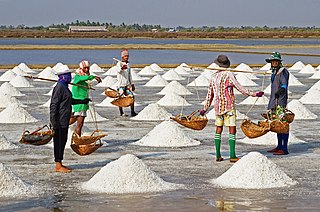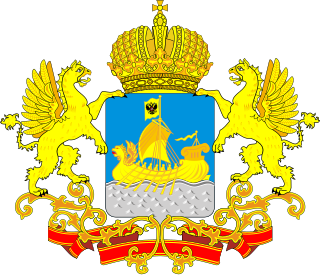Related Research Articles

A sausage is a type of meat product usually made from ground meat—often pork, beef, or poultry—along with salt, spices and other flavourings. Other ingredients, such as grains or breadcrumbs, may be included as fillers or extenders.

Salting is the preservation of food with dry edible salt. It is related to pickling in general and more specifically to brining also known as fermenting and is one form of curing. It is one of the oldest methods of preserving food, and two historically significant salt-cured foods are salted fish and salt-cured meat. Vegetables such as runner beans and cabbage are also often preserved in this manner.

Sea salt is salt that is produced by the evaporation of seawater. It is used as a seasoning in foods, cooking, cosmetics and for preserving food. It is also called bay salt, solar salt, or simply salt. Like mined rock salt, production of sea salt has been dated to prehistoric times.

Kala namak or black salt is a kiln-fired rock salt with a sulphurous, pungent smell used in the Indian subcontinent. It is also known as "Himalayan black salt", Sulemani namak, bit noon, bire noon, bit loona, bit lobon, kala loon, sanchal, kala meeth, guma loon, or pada loon, and is manufactured from the salts mined in the regions surrounding the Himalayas.

Kostroma is a historic city and the administrative center of Kostroma Oblast, Russia. A part of the Golden Ring of Russian cities, it is located at the confluence of the rivers Volga and Kostroma. In the 2021 census, the population is 267,481.

Kostroma Oblast is a federal subject of Russia. Its administrative center is the city of Kostroma and its population as of the 2021 Census is 580,976. It was formed in 1944 on the territory detached from neighboring Yaroslavl Oblast.

Buy is a town in Kostroma Oblast, Russia, which stands on the Kostroma River. Population: 20,564 (2021 Census); 25,763 (2010 Russian census); 27,392 (2002 Census); 32,701 (1989 Soviet census).

Galich is a town in Kostroma Oblast, Russia, located on the southern bank of Lake Galichskoye. As of the 2021 Census, its population was 12,856.

Caviar is a food consisting of salt-cured roe of the family Acipenseridae. Caviar is considered a delicacy and is eaten as a garnish or spread. Traditionally, the term caviar refers only to roe from wild sturgeon in the Caspian Sea and Black Sea. The term caviar can also describe the roe of other species of sturgeon or other fish such as paddlefish, salmon, steelhead, trout, lumpfish, whitefish, or carp.

Valenki are traditional Russian winter footwear, essentially felt boots: the name valenok literally means "made by felting". They are not water-resistant, and are often worn with galoshes to protect the soles from wear and moisture.

Soligalich is a town and the administrative center of Soligalichsky District in Kostroma Oblast, Russia, located on the right bank of the Kostroma River. Population: 6,438 (2010 Russian census); 6,996 (2002 Census); 7,456 (1989 Soviet census).

The Feodorovskaya Icon of the Mother of God, also known as Our Lady of Saint Theodore and the Black Virgin Mary of Russia, is the patron icon of the Romanov family. It is one of the most venerated icons in the Upper Volga region. Her feast days are March 14 (27) and August 29.

Kostroma Moose Farm is an experimental farm in Kostroma Oblast, Russia, where a herd of moose is kept, primarily for milk production; the farm supplies moose's milk to a nearby sanitorium. It is located near the village of Sumarokovo in Krasnoselsky District of Kostroma Oblast, some 25 km east of the city of Kostroma.
The Kostroma is a Russian cattle breed developed in the first half of the 20th century in the Kostroma Oblast of Russia's Upper Volga region, based mostly on crossbreeding local improved cattle with Brown Swiss, Allgau cattle and Ayrshire bulls. They are similar in appearance to Brown Swiss, but longer in head and body with a narrower forehead.

Denis Borisovich Glushakov is a Russian international footballer who plays as a defensive midfielder and box-to-box midfielder for Khimki.

The submarine incident off Kildin Island was a collision between the US Navy nuclear submarine USS Baton Rouge and the Russian Navy nuclear submarine B-276 Kostroma near the Russian naval base of Severomorsk on 11 February 1992. The incident occurred while the US unit was engaged in a covert mission, apparently aimed at intercepting Russian military communications. Although most sources claim that the American submarine was trailing her Russian counterpart, some authors believe that neither Kostroma nor Baton Rouge had been able to locate each other before the collision.

Century eggs, also known as alkalized or preserved egg, are a Chinese egg-based culinary dish made by preserving duck, chicken, or quail eggs in a mixture of clay, ash, salt, quicklime, and rice hulls for several weeks to several months, depending on the processing method.

Anzhelika Yegorovna Glazkova is a Russian political figure and a deputy of the 8th State Duma.

The Governor of Kostroma Oblast is the head of government of Kostroma Oblast, a federal subject of Russia.
References
- 1 2 "Kostroma Black Salt - Arca del Gusto". Slow Food Foundation. Retrieved 2023-10-28.
- 1 2 "What is thursday salt? How to prepare and use it? Magical use of Thursday salt. The forgotten taste of black salt. long history". obliznis.ru. Retrieved 2023-11-03.